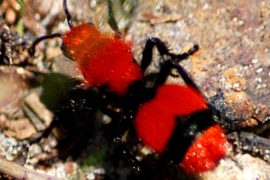What is the best method to fix epiphytes in the aquarium on the chosen substrate? It doesn’t matter whether you want to attach aquatic plants to roots, stones, or other surfaces – it is important to give the plant a reliable hold without damaging it. In our last post, we showed you which varieties are well suited as epiphytes. Today we will present the mounting options in more detail and explain what you should consider.
Stick on with underwater glue
It couldn’t be simpler: gluing on plant rhizomes has become possible in recent years with the introduction of non-toxic silicone glue that sets underwater. This method is used for the production of larger quantities of epiphytes on root wood, especially in nurseries, and has proven itself very well.
Modern underwater adhesives retain their adhesion even on wet surfaces. This offers us the opportunity to glue the thick rhizome roots of Anubien but also, for example, Cryptocoryne beckettii directly onto a lava rock or an aquarium root.
- To do this, take a large bowl about 3 cm filled with water and place the damp object on which the plants are to be glued in the middle. A spray bottle with fresh water should also be available.
- After the plants have been freed from the pots of any stone wool that may still be sticking under running water, place the sections to be glued on in the bowl ready to hand.
- If several aquarium plants are to be glued to one root, then start with the lower plants and slowly work your way up. For this purpose, an approx. 1-2 cm long strand of glue from the tube is applied to the root at a suitable point.
- The plant root is now pressed into the underwater glue in such a way that at least half of the rhizome is stuck in the glue strand.
- In the case of heavy plant parts, it may be necessary to fix them with a rubber band, for example. Small sections of Anubias barteri nana usually do without fixage.
- When working, you should occasionally moisten the leaves with the spray bottle so that they do not dry out.
- When all the pieces of the epiphyte are glued on, carefully place the whole thing in a large container of water. The underwater glue binds within 24 hours so that the root can go back into the aquarium. Full strength is achieved after three days.
Already knew?
Underwater glue is also ideal for fixing moss. It is best to use the practical gel moss glue in a small tube.
Tie up with binding wire
In addition to fishing lines and twine, the binding wire has proven particularly effective for tying up aquatic plants. The suitable wire is available in the craft departments of all hardware stores for little money. When buying, make sure that the binding wire is covered with plastic and is easy to bend with your fingers. We use OBI’s 2.95 wire as shown in the photo. Depending on the size of the plant, tweezers can also be helpful when fixing.
To prepare, proceed with gluing. So prepare a bowl with water and a sprayer and free the plant roots from the rock wool. You will also need pointed pliers and small side cutters.
When tying the epiphytes, push the binding wire through the root system so that the thick rhizome is in a wire loop. Then they estimate the length of the two protruding wire ends, which is necessary to twist the wire on the opposite side of the root.
Cut the wire accordingly and twist both ends behind the piece of root first with your fingers, then with the tip of the pliers. But beware! The rhizome must not be punctured by the wire or crushed too much. Therefore, the thinnest possible, slightly flexible binding wire is better than the thicker version. In between sprays, the plant leaves several times with water.
The advantage of the wire method is, of course, that the planted roots can be put straight back into the aquarium. However, this method requires a lot of finesse to avoid damaging the roots
Untie with twine or fishing line
Tying up with twine is the most common method for tying up aquarium plants – there is a piece of twine in every household that can be used to fasten the plants. The procedure is similar to tying up the plants with binding wire.
However, when using twine or similar, it is more difficult to fix the plants in the right position. Another disadvantage: Many cotton threads stretch underwater over time and the connection loosens as a result. Some even dissolve completely. If the plant has not yet established itself by then, this can be a problem. With aquarium plants that quickly find a foothold on the substrate, it can even be desirable for the threads to disappear by themselves after one.
If you want to avoid unraveling the line, choose thin nylon or a fishing line. It is barely visible and durable. However, when tying it up, be particularly careful not to constrict or damage the aquatic plants too tightly.
The best attachment method for epiphytes – our tip:
When asked about the best method of fixing epiphytic plants to the roots, we clearly tend towards the binding wire. We recommend fishing lines or glue for attaching aquatic plants to stones.
What do you think is the best method of attaching epiphytes to the aquarium? Testimonials are welcome!





